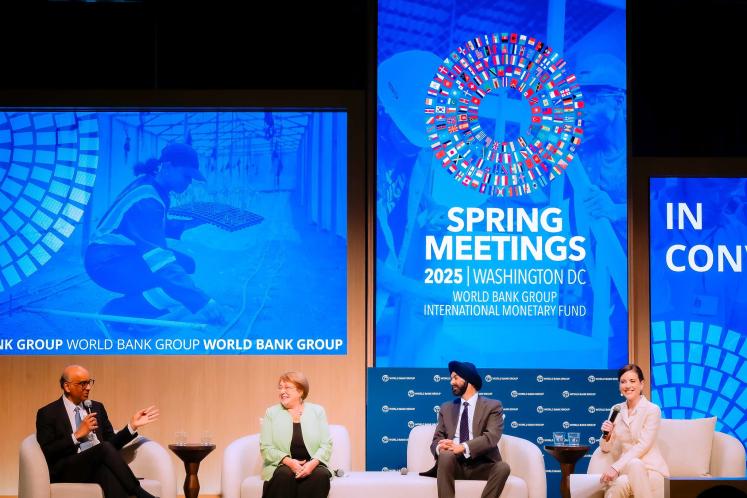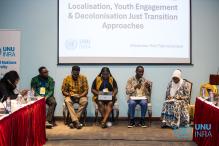Imagine the Spring Meetings of the IMF and World Bank taking place in April 2025—yet no one speaks about Donald Trump or the mounting threats to international cooperation under his administration. And yet, that’s exactly what happened.
Despite a global environment increasingly defined by disruption and fragmentation, the meetings proceeded with striking normalcy. Everyone present was well aware that the world of international cooperation is undergoing dramatic change. The idea that global collaboration is a win-win proposition—once a pillar of international policymaking—is now openly dismissed by the leader of the world’s richest and most influential country. And yet, it was left to the representatives of developing and developed countries alike to defend the multilateral system in Washington.
On the surface, one shift was immediately visible: the World Bank’s new president—appointed for his background in climate policy—initially emphasised the institution’s climate ambitions. But at the Spring Meetings, that priority seemed to quietly recede. “Climate creeps away” was how some observers summarised it.
Rising Doubts Over US Commitment
There is a growing sense among attendees and observers that the United States may retreat from the World Bank entirely. While the US Treasury Secretary made a point of stating that the US remains committed to engagement with both the IMF and the World Bank, few were reassured.
Speculation persists that the Trump administration is waiting to first reshape the financial framework within the IMF—particularly to create a privileged role for the US dollar—before severing ties with the World Bank, which appears to fit less neatly into the administration’s strategic vision.
Indeed, the so-called "Strategy 2025," long thought to reflect the intellectual and political underpinnings of Trump’s second term, advocates for a global financial system centred on the US dollar. While such a vision may not be achievable in practice, it reinforces the expectation that a US exit from the World Bank is not a matter of "if," but "when."
In this context, the Spring Meetings reflected a surprising degree of resilience among the international community. The determination to continue global development cooperation remained strong—despite clear signals that international financial support is shrinking. NGOs across the world have already begun to scale back programmes, anticipating major funding cuts—not just from the US, but from other governments leaning into populism.
The meetings took place in the shadow of two new shocks. The first: a trade shock, triggered by the United States’ announcement of new tariff hikes. The second: an aid shock, as donors on both sides of the Atlantic slashed official development assistance (ODA). These developments have implications for both Bretton Woods Institutions (BWIs): the IMF, as lender of last resort and guardian of financial stability; and the World Bank, as the leading development financier for low- and middle-income countries.
Still, the response from the BWIs was more or less: keep calm and carry on.
Policy Uncertainty: The New Normal?
At the start of the meetings, the United States was still reviewing its membership in key international organisations. As a result, neither IMF nor World Bank leadership knew where their largest shareholder stood. With the US Executive Director seats at both institutions still vacant, “policy uncertainty” became the buzzword of the week.
In her opening speech, IMF Managing Director Kristalina Georgieva framed uncertainty as a defining feature of the current global landscape. This theme carried over into flagship reports, including the 2025 Global Financial Stability Report.
While US delegates at the meetings criticised climate-related work at the BWIs, this had the unintended effect of galvanising other shareholders, 83% of whom (by voting weight) expressed strong support for continuing climate initiatives. Still, divisions remain—particularly at the World Bank, where debates are intensifying over energy financing, including support for gas and nuclear projects.
Deepening Divides, Delayed Reform
According to the World Economic Outlook, the twin shocks of trade disruption and aid cuts have raised the risk of a global recession—one that will hit poorer countries hardest. The G24 Communiqué warned that:
“Tariff increases could disproportionately impact EMDEs and Low-Income Countries, given their limited diversification and greater dependence on imported inputs.”
The G24 also called for reforms to reduce World Bank lending costs for middle-income countries, improvements to the G20’s Common Framework on debt treatment, and innovative ways to mobilise Special Drawing Rights.
The G20, however, failed to issue a consensus communiqué. A summary from the South African presidency signalled fractured views among members. Phrases like “many urged the need to reaffirm our commitment to multilateralism” made it clear that unity remains elusive.
Similarly, the IMF’s International Monetary and Financial Committee (IMFC) could only release a Chair’s Summary—not a joint statement. The Development Committee followed suit, offering a vague nod to private capital mobilisation and a renewed focus on “jobs.” But how, exactly, the World Bank intends to reach 1.5 billion people with quality health services and expand social protection to 500 million—with shrinking resources and sky-high private sector interest rates—remains unclear.
Debt Reform: A Concept in Search of Consensus
Debt was another central theme at the meetings. The Global Sovereign Debt Roundtable, co-convened by the BWIs, released a Restructuring Playbook. Yet, unlike the UNCTAD roadmap, the Playbook places the IMF at the heart of all proceedings—raising concerns about objectivity and political ownership.
Meanwhile, new proposals emerged on the sidelines. These included the Debt Relief for Resilience plan (launched by the International Institute for Sustainable Development), a call for a Global South Debtors’ Coalition from the South African Institute of Economic Justice, and the launch of the Expert Review on Debt, Nature and Climate, backed by Colombia, Kenya, France, and Germany.
The meetings also marked a milestone for the Jubilee 2025 campaign, which is pushing for real debt relief. While conceptual frameworks are advancing, actual political will remains in short supply.
What Comes Next? Sevilla and FfD4
Looking ahead, the next critical opportunity for global economic reform is the Fourth International Conference on Financing for Development (FfD4), set for 30 June–3 July 2025 in Sevilla. Unlike the IMF and World Bank, which are largely governed through finance ministries, FfD4 aims to bring reform discussions to the heads of state level.
This summit offers a once-in-a-decade chance to move past technical gridlock and reimagine the global financial architecture—whether by reforming the BWIs or reallocating mandates to more agile multilateral institutions. If sustainable development remains the priority, it may be time to do more than simply keep calm and carry on



